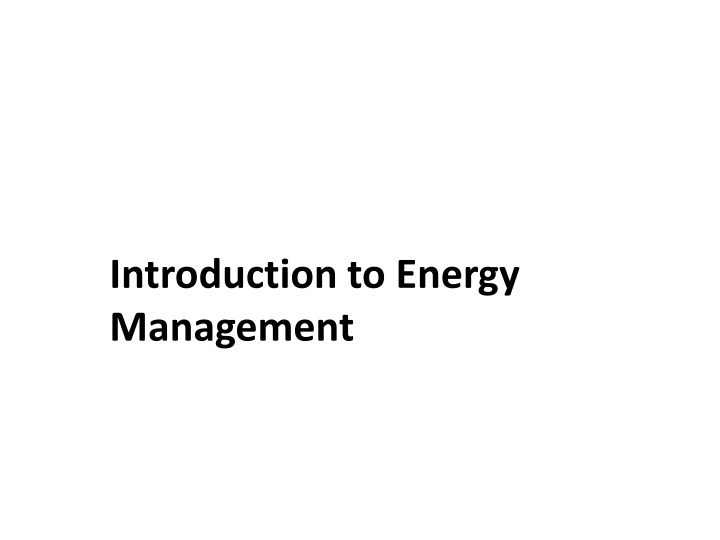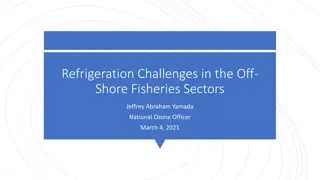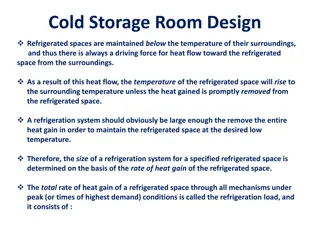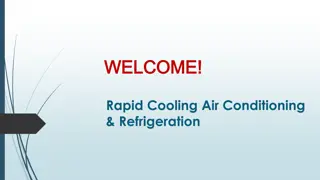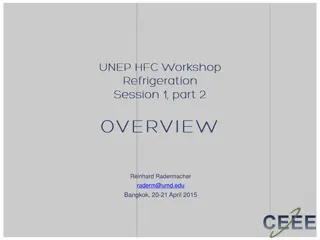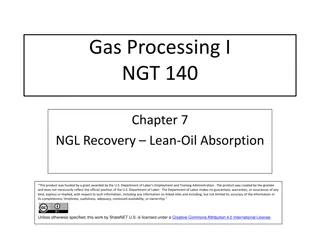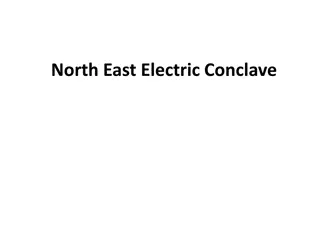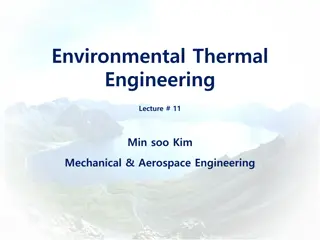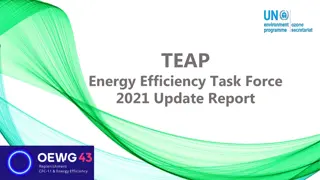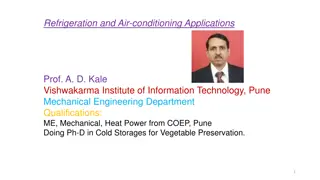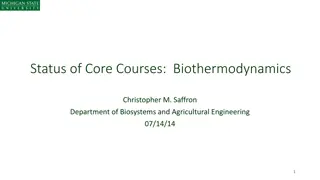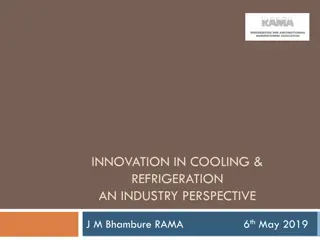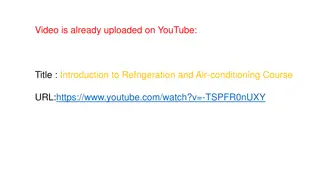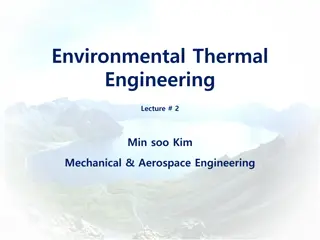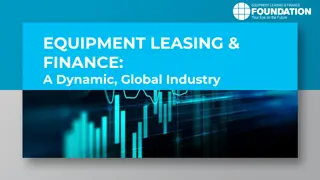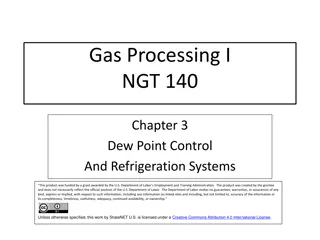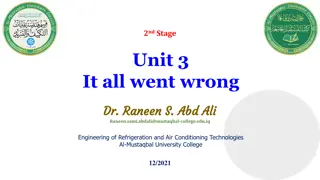Refrigeration Cycles and Equipment
Explore the fundamentals of mechanical and absorption refrigeration, refrigerant heat absorption and rejection, compressor types, condensers, expansion devices, evaporators, and the operation of absorption refrigeration cycles. Learn about refrigeration capacity, refrigerants, halogen refrigerants, and the temperature-pressure relationship in refrigeration systems.
Download Presentation

Please find below an Image/Link to download the presentation.
The content on the website is provided AS IS for your information and personal use only. It may not be sold, licensed, or shared on other websites without obtaining consent from the author.If you encounter any issues during the download, it is possible that the publisher has removed the file from their server.
You are allowed to download the files provided on this website for personal or commercial use, subject to the condition that they are used lawfully. All files are the property of their respective owners.
The content on the website is provided AS IS for your information and personal use only. It may not be sold, licensed, or shared on other websites without obtaining consent from the author.
E N D
Presentation Transcript
Introduction to Energy Management
Week/Lesson 7 Introduction to the Refrigeration Cycle and Equipment
Introduction to the Refrigeration Cycle and Equipment After completing this chapter, you will be able to Apply the general principles of mechanical and absorption refrigeration Explain how refrigerants absorb and reject heat Arrange the basic mechanical refrigeration cycle components in the proper order Describe the operating characteristics of various types of compressors
Introduction to the Refrigeration Cycle and Equipment Describe air and water-cooled condensers Describe various metering/expansion devices Describe the characteristics of DX coils and liquid chiller evaporators Describe the operation of the absorption refrigeration cycle
Introduction to the Refrigeration Cycle and Equipment General principles of refrigeration Process of extracting heat from a substance Window air conditioners and central systems Absorb heat from the occupied space Transfer this heat to the outside area Larger systems rely on the same principles
Introduction to the Refrigeration Cycle and Equipment Refrigeration capacity Rated in tons of refrigeration effect 1 Ton = 144 btu/lb x 2,000 = 288,000 Btu/day 1 Ton = 12,000 Btu/hr Example: System capacity = 1,200,000 Btu/hr 1,200,000/12,000 = 100 tons
Introduction to the Refrigeration Cycle and Equipment Refrigerants Absorb heat by evaporating a low temperature and pressure Reject heat by condensing at a higher temperature and pressure Halogen refrigerants are commonly used in mechanical refrigeration systems
Introduction to the Refrigeration Cycle and Equipment Temperature-pressure relationship of refrigerants Pressures are changed in order to change the saturation temperature of the refrigerant The P-T chart provides the relationship between the temperature and pressure of various refrigerants
Introduction to the Refrigeration Cycle and Equipment Basic mechanical refrigeration cycle Compressor raises the temperature and pressure of the refrigerant Condenser removes heat that was added to the system by the evaporator and compressor Metering device controls refrigerant flow to the evaporator Evaporator heat is absorbed from the space
Introduction to the Refrigeration Cycle and Equipment Compressors reciprocating Equipped with pistons and cylinders Suction and discharge valves Valve position is controlled by the pressure difference across it Can be open, semi-hermetic or fully hermetic
Introduction to the Refrigeration Cycle and Equipment Compressors rotary Uses circular motion to obtain compression Rotating blade (vane) type Refrigerant is trapped by the rotating vanes Refrigerant compresses as volume decreases Stationary blade (vane) type Equipped with only one blade or vane
Introduction to the Refrigeration Cycle and Equipment Compressors helical rotary (screw type) Utilizes two rotors: a male and a female Compressor capacity controlled by a slide valve A continuous, flowing output is produced The volume of the refrigerant decreases as it flows through the compressor
Introduction to the Refrigeration Cycle and Equipment Compressors scroll type Utilizes two identically machined scrolls One scroll is stationary, the other orbits The nesting of the scrolls traps vapor Gas is introduced from the outer edge Refrigerant is discharged from the center
Introduction to the Refrigeration Cycle and Equipment Compressors centrifugal type Rely on centrifugal force No pistons, valves or cylinders Utilizes an impeller Capacity is controlled by inlet vanes Used for very large applications
Introduction to the Refrigeration Cycle and Equipment Air-cooled condensers Desuperheating removes sensible heat (superheat) from the vapor refrigerant Condensing Vapor condenses into a liquid (latent heat) Subcooling Addition sensible heat is removed from the liquid refrigerant
Introduction to the Refrigeration Cycle and Equipment Water-cooled condensers Shell-and-tube Water circulates through the tubes Water makes several passes before exiting Hot gas enters the shell and condenses Mechanically cleanable
Introduction to the Refrigeration Cycle and Equipment Shell-and-coil Similar to the shell-and-tube Used in smaller applications Tubes are now in a coil shape Must be cleaned chemically
Introduction to the Refrigeration Cycle and Equipment Tube-within-a-tube Water flows in the inner tube Refrigerant flows in the outer tube Heat travels from the refrigerant To the surrounding air, and To the water in the coil
Introduction to the Refrigeration Cycle and Equipment Evaporative condenser Utilizes air and water Air flows over the coil Water can also flow over the coil if needed Latent and sensible heat transfers take place Water is heated and evaporated
Introduction to the Refrigeration Cycle and Equipment Metering devices Thermostatic expansion valve Constant pressure expansion valve Capillary tube High side float Orifice plates
Introduction to the Refrigeration Cycle and Equipment Thermostatic expansion valve Maintains constant superheat in the evaporator Three pressures control the valve position Bulb, spring and evaporator As the load increases the valve opens As the load decreases the valve closes
Introduction to the Refrigeration Cycle and Equipment Constant pressure expansion valve Maintains constant evaporator pressure An increase in evaporator pressure will cause the valve to close A decrease in evaporator pressure will cause the valve to open Commonly used on systems with constant loads
Introduction to the Refrigeration Cycle and Equipment Capillary tubes Seamless tubing with a small inside diameter No moving parts High side float valve Introduces refrigerant to the evaporator at the same rate as it leaves A float on the high side maintains proper flow
Introduction to the Refrigeration Cycle and Equipment Orifice plates Used primarily on centrifugal chillers Two plates with a series of holes in each The pressure drop across the plates changes with the load High load liquid passes the plates Low load some liquid flashes to a vapor
Introduction to the Refrigeration Cycle and Equipment Direct expansion coils Warm air passes over the cool coil Heat is transferred to the liquid refrigerant The liquid refrigerant begins to boil Vapor refrigerant leaves the evaporator Expansion valves control flow to the coil
Introduction to the Refrigeration Cycle and Equipment Evaporators for liquid chillers Direct expansion chilled water evaporator Refrigerant flows in the tubes Water fills the shell Flooded shell-and-tube Refrigerant is in the shell Water flows in the tubes
Introduction to the Refrigeration Cycle and Equipment Introduction to absorption refrigeration cycle Uses the physical properties of absorbents Low concentrations are weak or dilute solutions High concentrations are concentrated Systems use an absorbent and a refrigerant Absorbent: Lithium bromide Refrigerant: Water
Introduction to the Refrigeration Cycle and Equipment Absorption refrigeration cycle components Evaporator Absorber Concentrator Condenser
Introduction to the Refrigeration Cycle and Equipment Evaporator Operates at very low pressures (0.25 psia) Refrigerant (water) is sprayed into the shell Conditioned liquid gives up heat to the water The refrigerant boils and passes to the absorber Chilled water returns to the remote location
Introduction to the Refrigeration Cycle and Equipment Absorber Refrigerant from the evaporator enters absorber The refrigerant is absorbed by the absorber The rate of absorption is determined by the concentration of the solution Higher concentration lower chilled water temperature
Introduction to the Refrigeration Cycle and Equipment Concentrator Dilute absorbent solution flows to the concentrator Heat sources boil the refrigerant from the absorbent The solution now becomes highly concentrated The concentrated solution returns to the absorber
Introduction to the Refrigeration Cycle and Equipment Condenser Responsible for supplying liquid refrigerant to the evaporator The refrigerant vapor leaves the concentrator This vapor is condensed back to a liquid This liquid refrigerant returns to the evaporator
Refrigeration is the removal of heat from a material or space, so that it s temperature is lower than that of it s surroundings. When refrigerant absorbs the unwanted heat, this raises the refrigerant s temperature ( Saturation Temperature ) so that it changes from a liquid to a gas it evaporates. The system then uses condensation to release the heat and change the refrigerant back into a liquid. This is called Latent Heat . This cycle is based on the physical principle, that a liquid extracts heat from the surrounding area as it expands (boils) into a gas. To accomplish this, the refrigerant is pumped through a closed looped pipe system. The closed looped pipe system stops the refrigerant from becoming contaminated and controls its stream. The refrigerant will be both a vapor and a liquid in the loop.
Saturation Temperature can be defined as the temperature of a liquid, vapor, or a solid, where if any heat is added or removed, a change of state takes place. A change of state transfers a large amount of energy. At saturation temperature, materials are sensitive to additions or removal of heat. Water is an example of how saturation property of a material, can transfer a large amount of heat. Refrigerants use the same principles as ice. For any given pressure, refrigerants have a saturation temperature. If the pressure is low, the saturation temperature is low. If pressure is high, saturation temperature is high.
Latent Heat- The heat required to change a liquid to a gas (or the heat that must be removed from a gas to condense it to a liquid), without any change in temperature. Heat is a form of energy that is transferred from one object to another object. Heat Is a form of energy transferred by a difference in temperature. Heat transfer can occur, when there is a temperature difference between two or more objects. Heat will only flow from a warm object to a colder object. The heat transfer is greatest, when there is a large temperature difference between two objects.
The Refrigeration Cycle Graphic Demo There are four main components in a refrigeration system: The Compressor The Condensing Coil The Metering Device The Evaporator Two different pressures exist in the refrigeration cycle. The evaporator or low pressure, in the "low side" and the condenser, or high pressure, in the "high side". These pressure areas are divided by the other two components. On one end, is the metering device which controls the refrigerant flow, and on the other end, is the compressor.
The Compressor Demo The compressor is the heart of the system. The compressor does just what it s name is. It compresses the low pressure refrigerant vapor from the evaporator and compresses it into a high pressure vapor. The inlet to the compressor is called the Suction Line . It brings the low pressure vapor into the compressor. After the compressor compresses the refrigerant into a high pressure Vapor, it removes it to the outlet called the Discharge Line .
The Condenser Demo The Discharge Line leaves the compressor and runs to the inlet of the condenser. Because the refrigerant was compressed, it is a hot high pressure vapor (as pressure goes up temperature goes up). The hot vapor enters the condenser and starts to flow through the tubes. Cool air is blown across the out side of the finned tubes of the condenser (usually by a fan or water with a pump). Since the air is cooler than the refrigerant, heat jumps from the tubing to the cooler air (energy goes from hot to cold latent heat ). As the heat is removed from the refrigerant, it reaches it s saturated temperature and starts to flash (change states), into a high pressure liquid. The high pressure liquid leaves the condenser through the liquid line and travels to the metering device . Sometimes running through a filter dryer first, to remove any dirt or foreign particles.
Metering Devices Demo Metering devices regulate how much liquid refrigerant enters the evaporator . Common used metering devices are, small thin copper tubes referred to as cap tubes , thermally controller diaphragm valves called TXV s (thermal expansion valves) and single opening orifices . The metering device tries to maintain a preset temperature difference or super heat , between the inlet and outlet openings of the evaporator. As the metering devices regulates the amount of refrigerant going into the evaporator, the device lets small amounts of refrigerant out into the line and looses the high pressure it has behind it. Now we have a low pressure, cooler liquid refrigerant entering the evaporative coil (pressure went down so temperature goes down).
Thermal Expansion Valve Demo A very common type of metering device is called a TX Valve (Thermostatic Expansion Valve). This valve has the capability of controlling the refrigerant flow. If the load on the evaporator changes, the valve can respond to the change and increase or decrease the flow accordingly. The TXV has a sensing bulb attached to the outlet of the evaporator. This bulb senses the suction line temperature and sends a signal to the TXV allowing it to adjust the flow rate. This is important because, if not all, the refrigerant in the evaporator changes state into a gas, there could be liquid refrigerant content returning to the compressor. This can be fatal to the compressor. Liquid can not be compressed and when a compressor tries to compress a liquid, mechanical failing can happen. The compressor can suffer mechanical damage in the valves and bearings. This is called liquid slugging . Normally TXV's are set to maintain 10 degrees of superheat. That means that the gas returning to the compressor is at least 10 degrees away from the risk of having any liquid.
Evaporator Demo The evaporator is where the heat is removed from your house , business or refrigeration box. Low pressure liquid leaves the metering device and enters the evaporator. Usually, a fan will move warm air from the conditioned space across the evaporator finned coils. The cooler refrigerant in the evaporator tubes, absorb the warm room air. The change of temperature causes the refrigerant to flash or boil , and changes from a low pressure liquid to a low pressure cold vapor. The low pressure vapor is pulled into the compressor and the cycle starts over. The amount of heat added to the liquid to make it saturated and change states is called Super Heat . One way to charge a system with refrigerant is by super heat.
Review of Refrigeration Cycle Starting at the compressor; Low pressure vapor refrigerant is compressed and discharged out of the compressor. The refrigerant at this point is a high temperature, high pressure, superheated vapor. The high pressure refrigerant flows to the condenser by way of the "Discharge Line". The condenser changes the high pressure refrigerant from a high temperature vapor to a low temperature, high pressure liquid and leaves through the "Liquid Line". The high pressure refrigerant then flows through a filter dryer to the Thermal Expansion valve or TXV. The TXV meters the correct amount of liquid refrigerant into the evaporator. As the TXV meters the refrigerant, the high pressure liquid changes to a low pressure, low temperature, saturated liquid/vapor. This saturated liquid/vapor enters the evaporator and is changed to a low pressure, dry vapor. The low pressure, dry vapor is then returned to the compressor in the "Suction line". The cycle then starts over.
